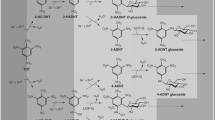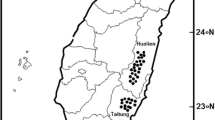Abstract
The contamination of the environment by explosives is a worldwide problem resulting in part from 2,4,6-trinitrotoluene (TNT) production. In situ phytoremediation is an appropriate, alternative, cost-effective technology to detoxify extended contamination of surface soil. The ability of rice (Oriza sativa) to both tolerate and assimilate 14C-labeled TNT was investigated over a 40-day exposure period. The germination rate decreased at 500 mg/kg TNT whereas root and shoot length increased significantly at high TNT concentrations, from 150 to 500 mg/kg. Rice took up TNT residues from soil and accumulated most in roots. Less than 25% of radioactivity taken up was translocated to aerial parts. Above 200 mg/kg TNT, the concentration of TNT residues in roots reached a maximum of approximately 0.7 mg/g. No TNT was found in plant extracts, good evidence for rapid metabolism of TNT. More than 60% of 14C activity was found as unextractable residues in roots. It was concluded that TNT metabolized and subsequently sequestered by roots could not be translocated to aerial parts.

Similar content being viewed by others
References
Alexander, M. (2000). Aging, bioavailability, and overestimation of risk from environmental pollutants. Environmental Science & Technology, 34, 4259–4265.
Best, E. P. H., Sprecher, S. L., Larson, S. L., Fredricksonn, H. L., & Bader, D. F. (1999). Environmental behavior of explosives in groundwater from the Milan Army ammunition plant in aquatic and wetland plant treatments. Uptake and fate of TNT and RDX in plants. Chemosphere, 39, 2057–2072.
Bhadra, R., Wayment, D. G., Hughes, J. B., & Shanks, J. V. (1999). Confirmation of conjugation processes during TNT metabolism by axenic plant roots. Environmental Science and Technology, 33, 446–452.
Briggs, G. G., Bromilow, R. H., & Evans, A. A. (1982). Relationships between lipophilicity and root uptake and translocation of non-ionised chemicals by barley. Pesticide Science, 13, 495–504.
Esteves-Nùñes, A., Caballero, A., & Ramos, J. L. (2001). Biological degradation of 2,4,6-trinitrotoluene. Microbiology and Molecular Biology Reviews, 65, 334–352.
Gong, P., Wilke, B. M., & Fleischmann, S. (1999). Soil-base phytotoxicity of 2,4,6-trinitrotoluene (TNT) to terrestrial higher plants. Archives of Environmental Contamination and Toxicology, 36, 152–157.
Görge, E., Brandt, S., & Werner, D. (1994). Uptake and metabolism of 2,4,6-Trinitrotoluene in higher plants. Environmental Science and Pollution Research, 1, 229–233.
Hannink, N., Rosser, S. J., & Bruce, N. C. (2002). Phytoremediation of explosives. Critical Reviews in Plant Sciences, 21, 511–538.
Honeycutt, M. E., Jarvis, A. S., & McFarland, V. A. (1996). Cytotoxicity and mutagenicity of 2,4,6-trinitrotoluene and its metabolites. Ecotoxicology and Environmental Safety, 35, 282–287.
Kim, J., Drew, M. C., & Corapcioglu, M. Y. (2004). Uptake and phytotoxicity of TNT in onion plant. Journal of Environmental Science and Health Part a-Toxic/Hazardous Substances & Environmental Engineering, 39, 803–819.
Medina, V. F., Maestri, E., Marmiroli, M., Dietz, A. C., & McCutcheon, S. C. (2003). Plant tolerances to contaminants. In J. L. Schnoor (Ed.), Phytoremediation—transformation and control of contaminants (pp. 189–232). Hoboken, New Jersey: Wiley.
Palazzo, A. J., & Leggett, D. (1986). Effect and disposition of TNT in a terrestrial plant. Journal of Environmental Quality, 15, 49–52.
Price, R. A., Pennington, J. C., Larson, S. L., Neumann, D., & Hayes, C. A. (2002). Uptake of RDX and TNT by agronomic plants. Soil and Sediment Contamination, 11, 307–326.
Robidoux, P. Y., Bardai, G., Paquet, L., Ampleman, G., Thiboutot, S., Hawari, J., & Sunahara, G. I. (2003). Phytotoxicity of 2,4,6-trinitrotoluene (TNT) and octahydro-1,3,5,7-tetranitro-1,3,5,7-tetrazocine (HMX) in spiked artificial and natural forest soils. Archives of Environmental Contamination and Toxicology, 44, 198–209.
Spain, J. (2000). Introduction. In H. Knackmuss (Ed.), Biodegradation of nitroaromatic compounds and explosives (pp. 1–5). Boca Raton, Florida: Lewis.
Talmage, S. S., Opresko, D. M., Maxwell, C. J., Welsh, C. J. E., Cretella, F. M., Reno, P. H., & Daniel, F. B. (1999). Nitroaromatic munition compounds: environmental effects and screening values. Reviews of Environmental Contamination and Toxicology, 161, 1–156.
Vila, M., Mehier, S., Pascal-Lorber, S., & Laurent, F. (2007). Phytotoxicity to and uptake of RDX by rice. Environmental Pollution, 145, 813–817.
Vila, M., Pascal-Lorber, S., Rathahao, E., Debrauwer, L., Canlet, C., & Laurent, F. (2005). Metabolism of [14C]-2,4,6-trinitrotoluene in tobacco cell suspension cultures. Environmental Science & Technology, 39, 663–672.
Author information
Authors and Affiliations
Corresponding author
Rights and permissions
About this article
Cite this article
Vila, M., Lorber-Pascal, S. & Laurent, F. Phytotoxicity to and uptake of TNT by rice. Environ Geochem Health 30, 199–203 (2008). https://doi.org/10.1007/s10653-008-9145-1
Received:
Accepted:
Published:
Issue Date:
DOI: https://doi.org/10.1007/s10653-008-9145-1




